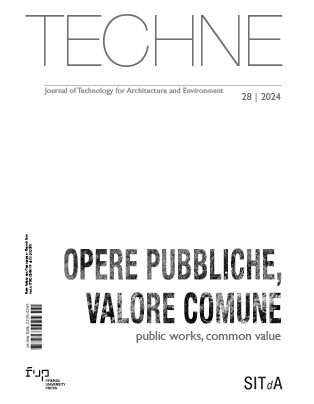Published 2024-10-29
Keywords
- Public space,
- Common good,
- Citizen involvement,
- Social inclusion,
- Cultural heritage
How to Cite
Copyright (c) 2024 Luca Reale

This work is licensed under a Creative Commons Attribution 4.0 International License.
Abstract
The case-study of Piazza Testaccio in Rome shows that public space, in order to be attractive, must necessarily be designed as a continuous plan open to the context. It also indicates that participatory processes are successful when they are the result of a concrete synergy between citizens, authorities and planners, and much less so when they respond to models and procedures imposed from above. The text traces the participatory design conception phase with the inhabitants, the formal, functional and technical-constructive choices, the implementation and the use of this new urban space in which people interact and meet, even casually, turning it into a “place” precisely through the individual and collective recognition of a community.
Downloads
References
- Arendt, H. (1994), Vita activa. La condizione umana, Bompiani, Milano (1° ediz. 1958).
- Bauman, Z. (2001), Voglia di comunità, Laterza, Roma-Bari.
- Bellone, C., Trevisani, P. and Colonna A., (2020) “Piazza Testaccio: esperienza di partecipazione nel recupero di uno spazio urbano nel centro storico di Roma”, Archivio di studi urbani e regionali, n. 128, pp. 64-79. Available at: http://dx.doi.org/10.3280/ASUR2020-128005. DOI: https://doi.org/10.3280/ASUR2020-128005
- Bonaiti, M. (2002), a cura, Architettura è. Louis I. Khan, gli scritti, Electa, Milano.
- Consiglio d’Europa (2005), Convenzione quadro del Consiglio d’Europa sul valore dell’eredità culturale per la società, (CETS NO. 199) Faro, 27.X.2005. Available at: http://musei.beniculturali.it/wp-content/uploads/2016/01/Convenzione-di-Faro.pdf (Accessed on 29/02/2024).
- Foucault, M. (1976), Sorvegliare e punire, Einaudi, Torino.
- Jacobs, J. (1992), The Death and Life of Great American Cities, Vintage Books ed., New York, p. 84 (1st ed. 1961).
- López Cano, J. (2020), Urbanità spontanee, Libria, Melfi.
- Murphy, K.D. and O’Driscoll, S., (Eds.) (2021), Public Space/Contested Space. Imagination and Occupation, Routledge, New York. DOI: https://doi.org/10.4324/9781003095262
- Secchi, B. (2013), La città dei ricchi e la città dei poveri, Laterza, Roma-Bari.
- Sennett, R. (2018), Costruire e abitare. Etica per la città, Einaudi, Torino.
- Serena, K.L., Hauderowicz, D., eds. (2020), Age-Inclusive Public Space, Hatje Cantz, Berlin.
- Whyte, W.H. (1980), The Social Life of Small Urban Spaces. Conservation Foundation, Washington DC.






